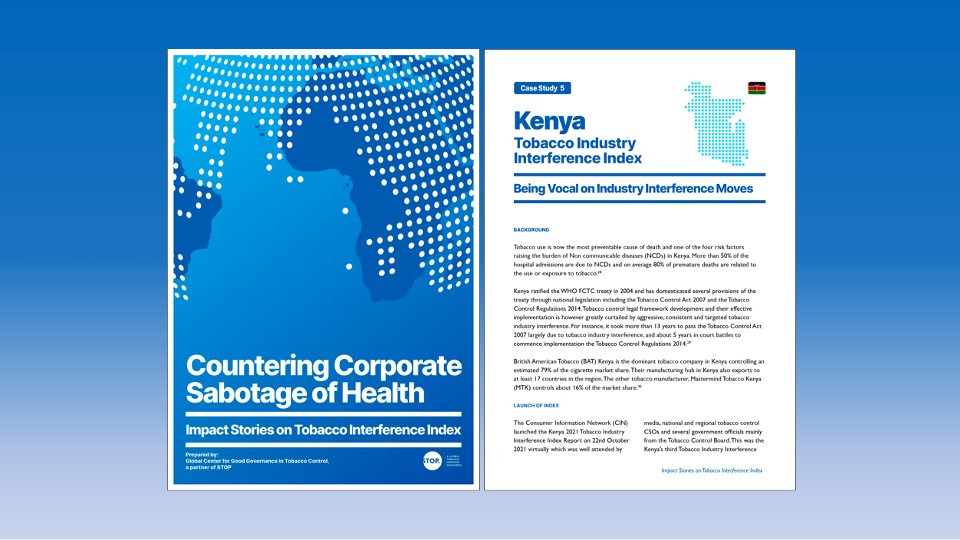Being Vocal on Industry Interference Moves Tobacco Control

“Tobacco control is being hampered by an industry that is ensuring that it subverts public health policy development and implementation through dubious means. Kenya Tobacco Industry Interference Index investigates, exposes and helps counter both overt and covert tactics of the tobacco industry on tobacco control in Kenya.”
Samuel Ochieng
Chief Executive Officer, Consumer Information Network, Kenya
Background
Tobacco use is now the most preventable cause of death and one of the four risk factors raising the burden of Non communicable diseases (NCDs) in Kenya. More than 50% of the hospital admissions are due to NCDs and on average 80% of premature deaths are related to the use or exposure to tobacco.[i]
Kenya ratified the WHO FCTC treaty in 2004 and has domesticated several provisions of the treaty through national legislation including the Tobacco Control Act 2007 and the Tobacco Control Regulations 2014. Tobacco control legal framework development and their effective implementation is however greatly curtailed by aggressive, consistent and targeted tobacco industry interference. For instance, it took more than 13 years to pass the Tobacco Control Act 2007 largely due to tobacco industry interference, and about 5 years in court battles to commence implementation the Tobacco Control Regulations 2014.[ii]
British American Tobacco (BAT) Kenya is the dominant tobacco company in Kenya controlling an estimated 79% of the cigarette market share. Their manufacturing hub in Kenya also exports to at least 17 countries in the region. The other tobacco manufacturer, Mastermind Tobacco Kenya (MTK) controls about 16% of the market share.[iii]
Launch of Index
The Consumer Information Network (CIN) launched the Kenya 2021 Tobacco Industry Interference Index Report on 22nd October 2021 virtually which was well attended by media, national and regional tobacco control CSOs and several government officials mainly from the Tobacco Control Board. This was the Kenya’s third Tobacco Industry Interference Report by CIN. The findings of the Kenya Index were also publicised in the other partner organisations’ websites and also highlighted in the Regional and Global Tobacco Industry Interference Index Reports to ensure a wider reach.[iv] [v]
Like the previous two indices, the launch of the 2021 Kenya Tobacco Industry Interference Index was well attended by media outlets. There was wide media coverage, including on social media and several interviews on radio and TV about Kenya’s performance in the Index.[vi] [vii] [viii]
Outcome of Advocacy with the Index
CIN also presented the Index to select government departments/authorities particularly those mentioned in the report as having had interactions with the tobacco industry in a manner that is contrary to the provisions of FCTC Article 5.3 and Part 5 of the Tobacco Control Regulations 2014.
Looking at the evolving tobacco control landscape in Kenya since the launch of the first Index in 2019, advocacy around it has made it possible to mainstream and establish tobacco industry monitoring amongst tobacco control advocates and organisations. Tobacco industry monitoring is fast getting traction including in the Ministry of Health. There is now greater openness from the Ministry of Health officials on sharing information on instances of tobacco industry interactions with government compared to previously.
Government officials are also becoming more vocal in calling out tobacco industry interference at national events and at international meetings such as the WHO FCTC COP9. The Ministry of Health is also more open to civil society calling out tobacco industry interference at events where high-ranking government officials are to support sensitisation and awareness creation across government. For example, CIN was given the opportunity to present the tobacco industry interference index during the main event to mark the World No Tobacco Day in 2021.
Although more needs to be done, there already have been a few instances of industry push back such as the approval of the nicotine pouches following the awareness being created with the advocacy using the index among other interventions.
About Consumer Information Network: CIN is a an independent non-political, non-profit- national consumer organization founded and registered in 1994. The main objective of CIN is to protect consumer rights and promote consumer responsibility.
[i] Ministry of Health - Kenya. Tobacco use leading cause of preventable death. 31 May 2017. Available from: https://bit.ly/3QuLizC
[ii] Tobacco Tactics. Kenya- BAT’s Tactics to Undermine the Tobacco Control Regulations. 05 February 2020. Available from: https://bit.ly/3xZozV3
[iii] Tobacco Tactics. Kenya Country Profile. 14 September 2021. Available from: https://bit.ly/39xsteo
[iv] Kenya Tobacco Control Alliance. Kenya Tobacco Industry Interference Index 2020. 14 August 2020. Available from: https://bit.ly/3b3oZke
[v] ATCA. Gov’t urged to implement the 2021 Tobacco industry interference report. 21 October 2021. Available from: https://bit.ly/3xy9aJY
[vi] Baraka FM. Gov’t urged to implement the 2021 Tobacco industry interference report. 22 October 2021. Available from: https://bit.ly/3tJx9F0
[vii] The Standard. Report calls out tobacco industry for interference. Available from: https://bit.ly/3xXCOJW
[viii] The Star. Tobacco firm donation to Covid-19 kitty costs Kenya. 31 October 2021. Available from: https://bit.ly/3Ohi2KI
